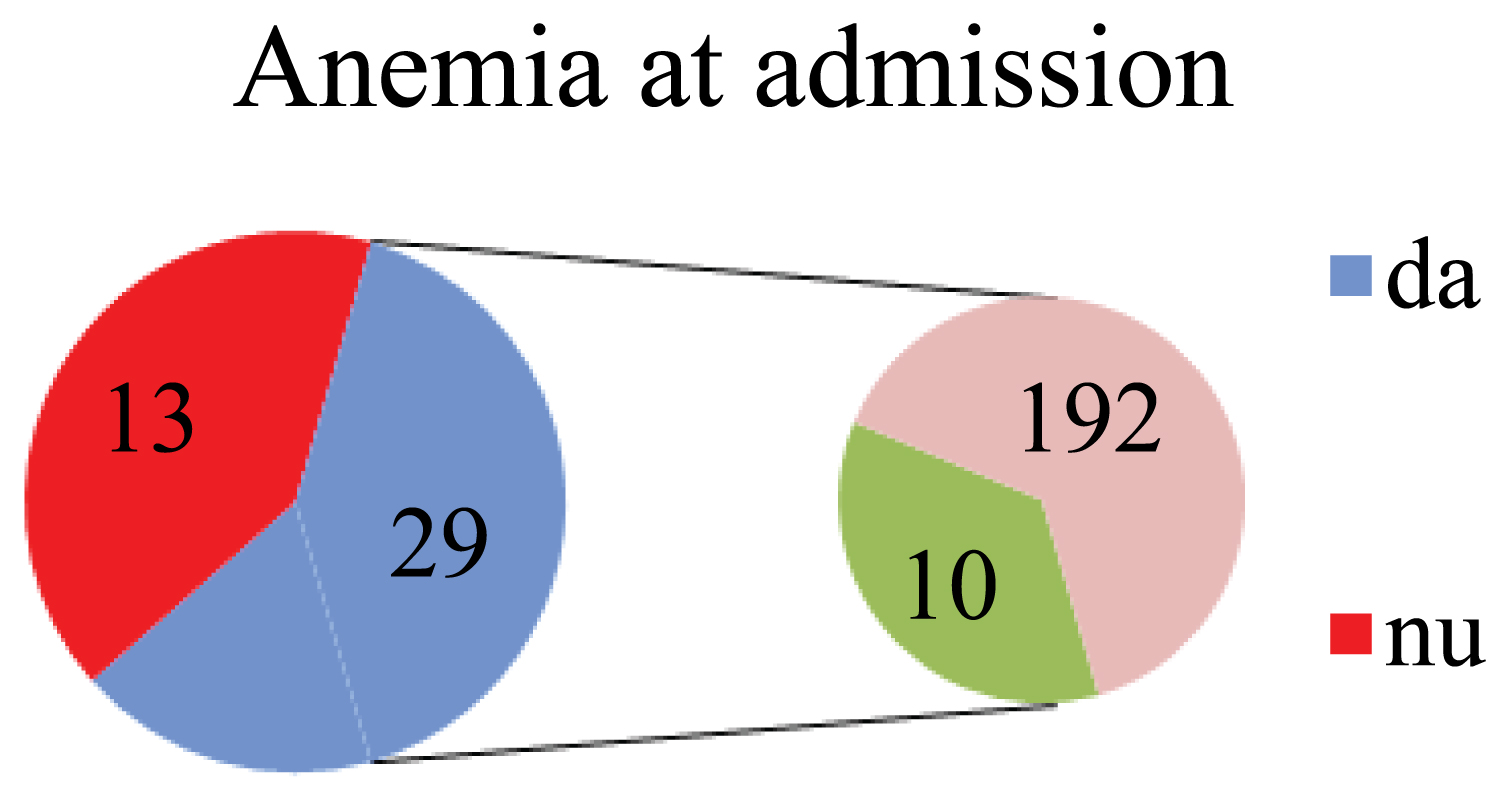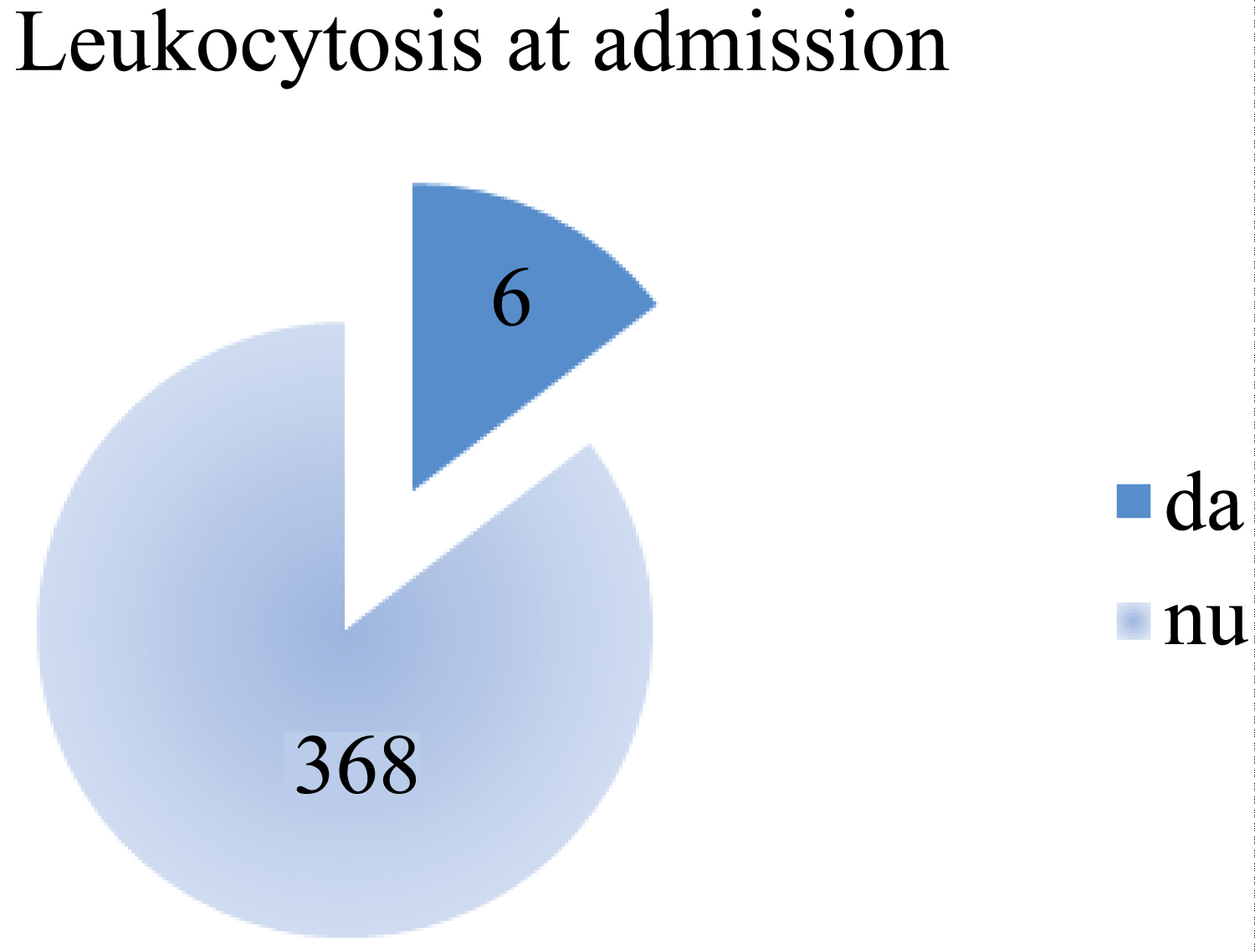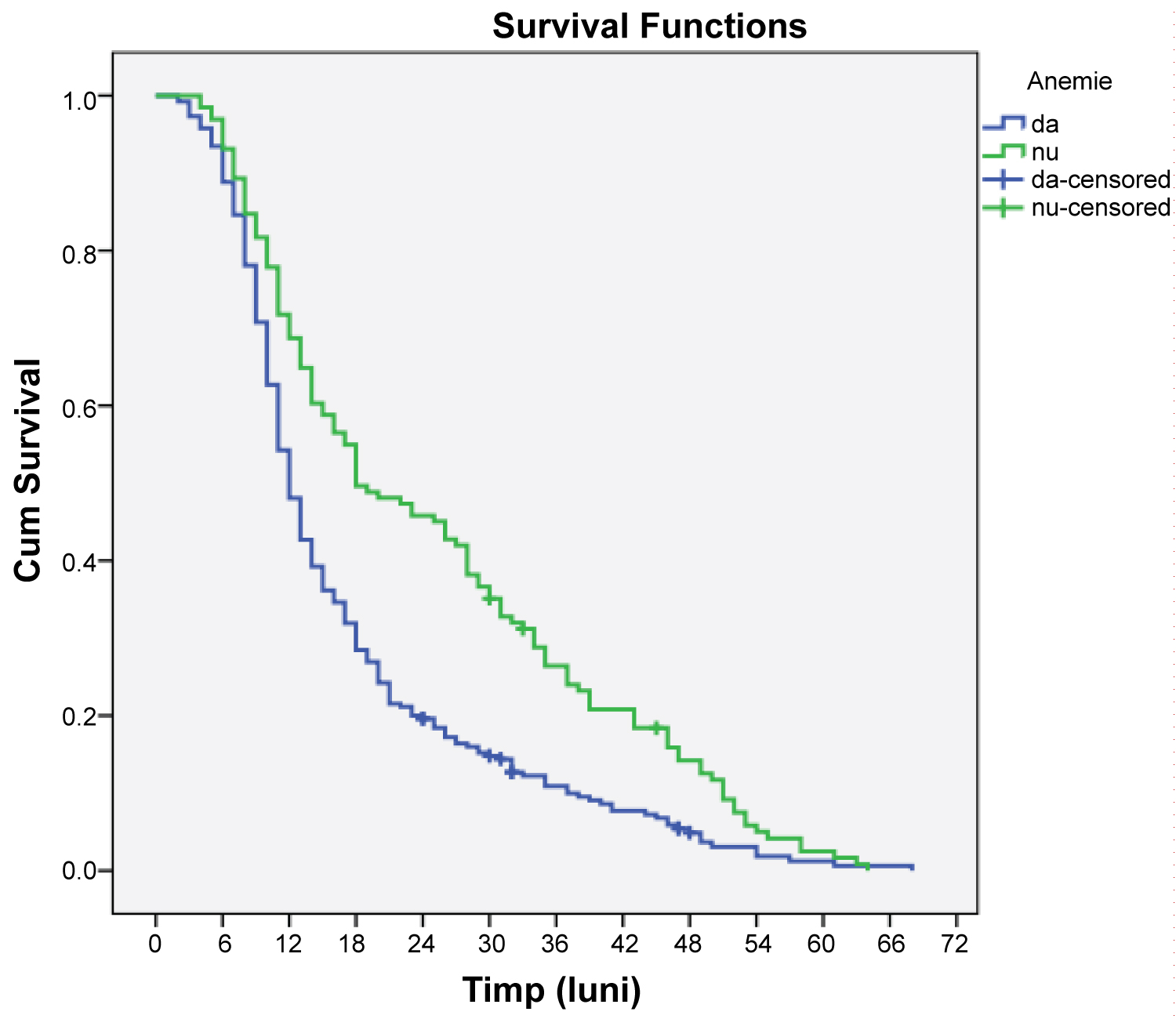The Complete Blood Count Modified Results in Patients with Complicated Colorectal Cancer
Abstract
Introduction
Among the factors on which the long-term survival of patients with colorectal cancer depends, the biological status at admission is essential and it is well reflected by a simple, routine analysis: The complete blood count (CBC). The link between the values of the hemoleukogram parameters and the diagnosis of colorectal cancers, but also between the changes in the hemoleukogram and the prognosis of patients with colorectal cancer is well documented in the literature. The aim of this study is to show the link between CBC changes at admission and the survival of patients with complicated colorectal cancer.
Patients and methods
We conducted a retrospective study that included 431 patients admitted and operated in emergency for complicated colorectal cancer, in the Surgery II Clinic of the Clinical Emergency County Hospital "St. Ap. Andrei" from Galati between 2008-2017. We made statistical correlations between the 4 types of emergency operations (external derivations, Hartmann, internal derivations and resections with anastomosis) and CBC changes, as well as a survival analysis depending on the presence of these changes.
Results
The presence of anemia at admission is statistically significant correlated with the practice of emergency colostomies and the presence of leukocytosis is correlated with Hartmann operations. In our study, only the anemia was a negative prognostic factor for the long-term survival of patients with complicated colorectal cancer.
Conclusions
The complete blood count is a routine, simple, cost-effective laboratory test that can be a very useful tool in assessing the prognosis of patients with complicated colorectal cancer.
Keywords
Complete blood count, Complicated colorectal cancer
Introduction
According to the data provided by the GLOBOCAN 2018 statistics, which sums up data from 185 countries, the colorectal cancer ranks 3rd in incidence globally (after lung and breast cancer) and 2nd in mortality by cancer (after lung cancer) [1]. Despite the improvements in diagnostic tools and screening options, a worrying percentage of patients still present in emergency with complicated tumors.
Although many therapeutic strategies have been developed in recent decades the long-term survival of patients with colorectal cancer, especially those presenting in emergency with complicated tumors, remains unsatisfactory [2].
The factors on which the long-term survival of patients with colorectal cancer, operated in emergency, depend on: Age, biological status at admission, symptoms, tumor location, invasion of neighboring organs, presence of secondary disseminations, type of surgery, need for reinterventions, postoperative complications , histological type, tumor grading and staging [3,4]. Of all these factors, the biological status at admission is essential and it is well reflected by a simple, routine analysis: The complete blood count.
Several studies have shown the link between the values of hemoleukogram parameters and the diagnosis of colorectal cancers [5-7], but also between hemoleukogram changes and the prognosis of patients with colorectal cancer [8].
The aim of this study is to show the link between CBC changes at admission and the survival of patients with complicated colorectal cancer.
Patients and Methods
We conducted a retrospective study that included 431 patients admitted and operated in emergency for complicated colorectal cancer, in the Surgery II Clinic of the Clinical Emergency County Hospital "St. Ap. Andrei" from Galati between 2008-2017.
The patient data were collected from observation sheets, surgical protocols and histopathological reports.
We analyzed the following paraclinical factors: Hemoglobin, hematocrit, leukocyte and platelet values at admission.
We made statistical correlations between the 4 types of emergency operations (external derivations, Hartmann, internal derivations and resections with anastomosis) and CBC changes, as well as a survival analysis depending on the presence of these changes.
Statistical analysis
The survival analysis was made from the time of diagnosis until the time of death of patients or until the end of follow-up in the study (01.10.2019).
As prognostic factors, survival curves were analyzed using the Kaplan-Meier method and the analysis of statistical significance was performed with the Log Rank (Mantel-Cox) and Breslow (Generalized Wilcoxon) tests.
The mean and median for the survival time were calculated for estimating survival at 6, 12, 18, 24, 48, and 60 months.
The statistical analysis was performed using SPSS software (version 23.0). Statistical conclusions were formulated using as a statistically significant difference threshold the value p < 0.05 for all calculations performed.
Results
Of the patients included in the study, 299 (69.37%) were anemic at admission. Of these, 107 required whole blood transfusions or erythrocyte mass (Figure 1). According to the reference interval of the laboratory of the Clinical Emergency County Hospital from Galati, we considered anemia hemoglobin values lower than 11 g/dl and hematocrit values lower than 35%.
63 patients (14.61%) had leukocytosis at admission (a number of leukocytes > 10000/µl) (Figure 2).
The statistical analysis regarding the correlation of the types of operations performed with the laboratory analyzes at admission revealed the following data: Statistically significant difference between patients with anemia who underwent colostomies, respectively Hartmann operations (p value = 0.002115- Pearson test Chi-Square); statistically significant difference between patients with anemia needing transfusions at whom we practiced colostomies, respectively internal derivations (p value = 0.018961- Pearson Chi-Square test) (Table 1).
We also found significant differences in the correlation of the type of emergency surgery with the presence of leukocytosis at admission. Thus, in patients with leukocytosis at admission, Hartmann-type interventions were preferred over colostomies (p value = 0.000342- Pearson Chi-Square test) (Table 1).
The survival analysis
The presence of anemia at admission (Table 2): Of the 260 patients with anemia at admission, 251 died and 9 (3.5%) survived until 01.10.2019. Of the 131 patients without anemia at admission, 128 died and 3 (2.3%) were alive by the end of the study.
Comparing the survival on the 2 groups, there is a statistically significant difference (test for the 2 curves: p value = 0.000006 Log Rank (Mantel-Cox)) (Table 3).
On the graph it can be seen that the 2 survival curves for patients with anemia at admission and those without anemia do not overlap (Figure 3).
The mean estimated survival time to death for patients with anemia at admission is 17,124 and for patients without anemia is 25,151. The median survival time for patients with anemia is 12,000 and for patients without anemia is 18,000 (Table 4).
The risk of death for patients with anemia is: HR = 1,272, 95% CI = (1,141, 1.418) (p value = 0.000015) (Table 5). So the presence of anemia is a risk factor.
The percentages of patients surviving at various times (6 months, 12 months, etc.) are explicitly shown in Table 6. The 5-years survival of patients with anemia at admission is 1.2%, while in patients without anemia, the 5-years survival is 2.5%.
The presence of severe anemia with preoperative transfusion requirements (Table 7): Of the 81 patients with anemia needing transfusions, 79 died and 2 (2.5%) survived until 01.10.2019. Of the 310 patients without anemia needing transfusions, 300 died and 10 (3.2%) were alive at the end of the study.
Comparing the survival on the 2 groups, no statistically significant difference is found (test for the 2 curves: p value = 0.921275 Log Rank (Mantel-Cox)) (Table 8).
The presence of leukocytosis at admission (Table 9): Of the 46 patients with leukocytosis at admission, 45 died by 01.10.2019, and 1 (2.2%) survived. Of the 345 patients without leukocytosis at admission, 334 died and 11 (3.2%) were alive at the end of the study.
Comparing the survival on the 2 groups, we find a difference close to the limit of statistical significance (test for the 2 curves: p-value = 0.099868 Log Rank (Mantel-Cox)) (Table 10).
The presence of thrombocytopenia at admission (Table 11): Of the 6 patients with thrombocytopenia at admission, none survived until 01.10.2019. Of the 385 patients without thrombocytopenia, 373 died and 12 (3.1%) were alive at the end of the study.
Comparing the survival on the 2 groups, no statistically significant difference is found (test for the 2 curves: p value = 0.106936 Log Rank (Mantel-Cox)) (Table 12).
Discussions
There are numerous studies in the literature evaluating the link between changes in complete blood count results and the survival of colorectal cancer patients, but few include patients operated in emergency.
In this study, in which we included only patients with complicated colorectal tumors, we showed that anemia is a risk factor and for the other parameters no statistical significance was obtained.
We showed that the presence of anemia at admission correlates well with the practice of colostomes in emergency and the presence of leukocytosis correlates with Hartmann operations. In our study, only the anemia was a negative prognostic factor for the long-term survival of patients with complicated colorectal cancer.
The anemia is very common in patients with colorectal cancer, as shown by most studies [9-13]. A recent study, published in Brazil, shows that the anemia is a risk factor for patients with colorectal cancer operated in emergency, as in our study, and anemia with transfusion requirements was an independent risk factor [14], a correlation which we did not find.
The leukocytosis, a faithful sign of the presence of inflammation and/or infection, has been associated with the practice of Hartmann surgery in other studies [15,16], as in our study.
Some recent studies indicate the leukocytosis as a prognostic factor for colorectal cancer patients [17], which we did not find in our study.
Some authors found a shorter survival in patients with complicated colorectal cancer with preoperative thrombocytosis [18], a correlation that we did not find in our study.
Conclusions
We obtained statistically significant results in correlating colostomies with the presence of anemia at admission and correlating Hartmann operations with the presence of leukocytosis at admission.
The anemia turned out to be a paraclinical prognostic factor for patients with complicated colorectal cancer. The complete blood count is a routine, simple, cost-effective laboratory test that can be a very useful tool in assessing the prognosis of patients with complicated colorectal cancer.
References
- Bray F, Ferlay J, Soerjomataram I, et al. (2018) Global cancer statistics 2018: GLOBOCAN estimates of incidence and mortality worldwide for 36 cancers in 185 countries. CA Cancer J Clin 68: 394-424.
- Wu Q, Hu T, Zheng E, et al. (2017) Prognostic role of the lymphocyte-to-monocyte ratio in colorectal cancer: An up-to-date meta-analysis. Medicine (Baltimore) 96: e7051.
- F Zaharie, L Mocan, T Mocan, et al. (2011) Managementul chirurgical în urgen?a al ocluziilor prin cancere colonice ?i rectale. Chirurgia 106: 479-484.
- Barbulescu M (2007) Factorii prognostici ai cancerului colorectal (I). Jurnalul de Chirurgie Ia?i 3: 117-129.
- Spell DW, Jones DV, Harper WF, et al. (2004) The value of a complete blood count in predicting cancer of the colon. Cancer Detect Prev 28: 37-42.
- Hamilton W, Lancashire R, Sharp D, et al. (2008) The importance of anaemia in diagnosing colorectal cancer: A case-control study using electronic primary care records. Br J Cancer 98: 323-327.
- Virdee PS, Kirtley S, Elhussein L, et al. (2019) Components of the full blood count as risk factors for colorectal cancer detection: A systematic review protocol. BMJ Open 9: e032759.
- Birks J, Bankhead C, Holt TA, et al. (2017) Evaluation of a prediction model for colorectal cancer: Retrospective analysis of 2.5 million patient records. Cancer Med 6: 2453-2460.
- Väyrynen JP, Tuomisto A, Väyrynen SA, et al. (2018) Preoperative anemia in colorectal cancer: Relationships with tumor characteristics, systemic inflammation, and survival. Sci Rep 8: 1126.
- Siegel R, Ma J, Zou Z, et al. (2014) Cancer statistics, 2014. CA Cancer J Clin 64: 9-29.
- Sadahiro S, T Suzuki, N Tokunaga, et al. (1998) Anemia in patients with colorectal cancer. J Gastroenterol 33: 488-494.
- James R Dunne, Christopher J Gannon, Tiffany M Osborn, et al. (2002) Preoperative anemia in colon cancer: Assessment of risk factors. Am Surg 68: 582-587.
- Constantin GB, Berbece S, Voicu D, et al. (2020) The use of Metronidazole in Clostridium difficile infection at patients with complicated colorectal cancers operated in emergency. Rev Chim 71: 516-521.
- Ramos RF, Santos Dos-Reis LC, Beatriz Esteves Borgeth Teixeira, et al. (2017) Cirurgia no cancer de colon empacientes operados de emergencia. Rev Col Bras Cir 44: 465-470.
- Moghadamyeghaneh Z, Hanna M, Carmichael J, et al. (2015) Preoperative leukocytosis in colorectal cancer patients. J Am Coll Surg 221: 207-214.
- Gastinger I, Marusch F, Koch A, et al. (2004) Hartmann's procedure indication in colorectal carcinoma. Chirurg 75: 1191-1196.
- Diefenhardt M, Hofheinz RD, Martin D, et al. (2019) Leukocytosis and neutrophilia as independent prognostic immunological biomarkers for clinical outcome in the CAO/ARO/AIO-04 randomized phase 3 rectal cancer trial. Int J Cancer 145: 2282-2291.
- Xu-Dong R, Zhang H, Wang XP, et al. (2018) Poor prognostic role of the pretreatment platelet counts in colorectal cancer. Medicine(Baltimore) 97: e10831.
Corresponding Author
Georgiana Bianca Constantin, Faculty of Medicine and Pharmacy, Dunarea de Jos University, Galati, Romania, Tel: 0749058284.
Copyright
© 2020 Constantin GB, et al. This is an open-access article distributed under the terms of the Creative Commons Attribution License, which permits unrestricted use, distribution, and reproduction in any medium, provided the original author and source are credited.







